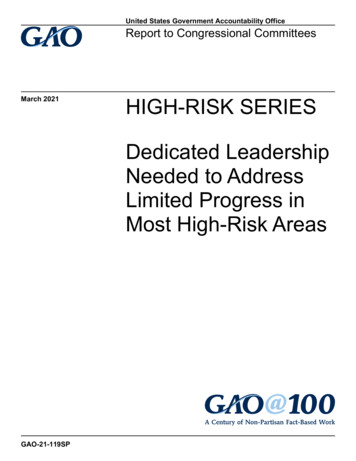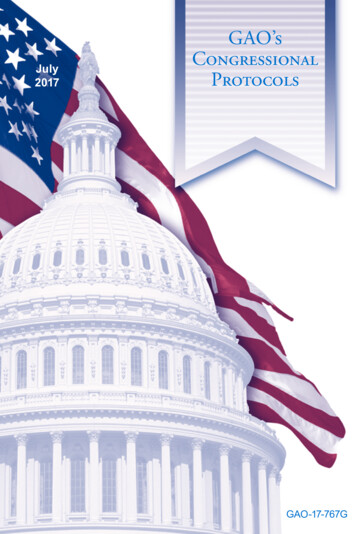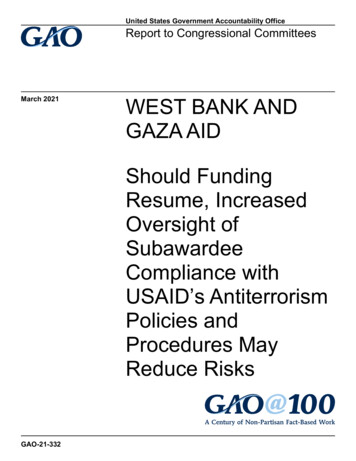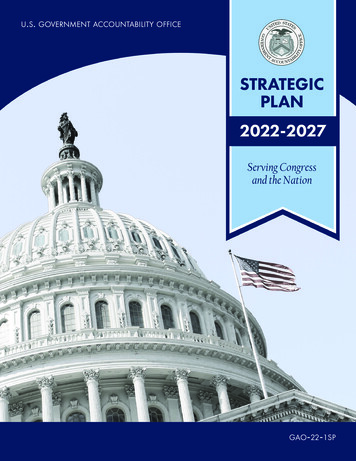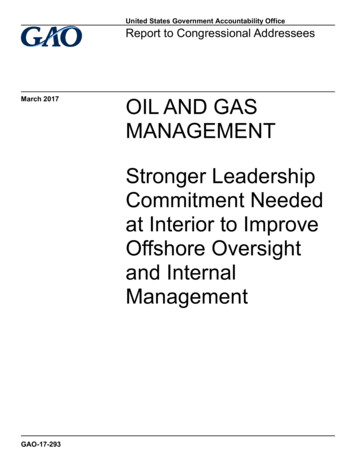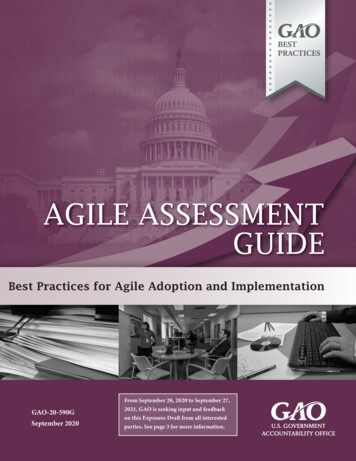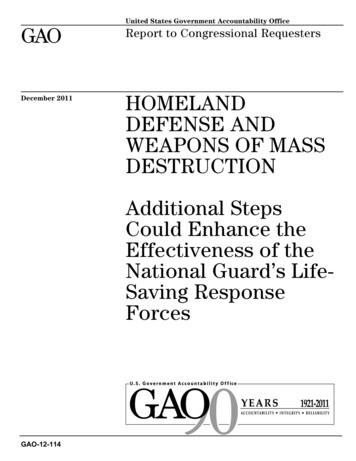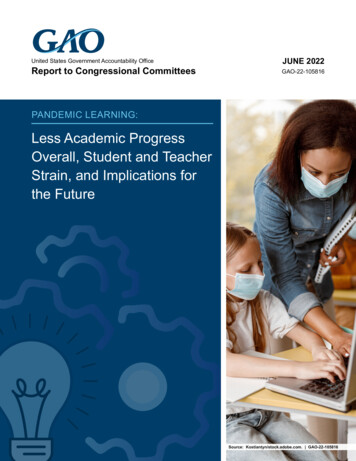
Transcription
“l ” . -.l l ”“.l * . .““.C”“,“ll” .“--. . ,“.”. ,.I .“.-- l -G AOU N EM PL O YEDPARENT SA n E v a l u a ti o n o f th eE ffe c ts o f W e l fa reB e n e fi ts o n F a m i l yS ta b i l i tyII IIIN146400G A O II’E M D -9 2 -1 S R R
,, , . . - .,. ”.,. II . .-.-. -. l.l. I. .- I. I.- --.--.-l l - -. -.---
GA!0Uni t edStatesGeneralAccounti n gOffi c eWashi n gton,D.C. 20548ProgramEval u ati o nMethodol o gyDi v i s i o nandB-246812Apri l 2 9,1992The Honorabl eLl o ydChai r man,Commi t teeUni t ed States SenateBentsenon Fi n anceDear Mr. Chai r man:Thi s i s the secondreport respondi n gto your request for i n formati o non theAi d to Fami l i e swi t h DependentChi l d ren-Unempl o yedParents (@DC-UP)program.Our fi r st report (Unempl o yedParents: Ini t i a lEfforts to ExpandState Assi s tance,GAO/PEMD-92-l1, January1992) presenteddescri p ti v edata on how the states respondedto the mandatei n the Fami l ySupport Actof 1988 to expandthe previ o usl yvol u ntaryUP porti o nof the AFDC programto al l states. On February12, 1992, we bri e fedyour staff on the resul t s ofour secondrevi e w, whi c h are summari z edi n thi s report. Addressi n gyouri n teresti n the effect of the AFDC-UP programon fami l y stabi l i t y,the reportfi n ds mi x ed evi d enceon whetherthe presenceof the programaffectsAFDC-Basi c casel o ads.Thi s report does not provi d econcl u si v esupportfor ei t her si d e of thedebate over the possi b l econsequencesof the recent expansi o nof AFx)C-up.Proponentsof the expansi o nof the programargued that the avai l a bi l i t yofthi s assi s tancewoul d encouragestabi l i t yamong poor fami l i e s.Theyreasonedthat the avai l a bi l i t yof assi s tancefor poor two-parentfami l i e swoul d remove the i n centi v efor fami l i e sexperi e nci n geconomi chardshi p sto separatei n order to recei v ebenefi t sfrom the AFDC-Basi c program(whi c h are reservedpri m ari l yfor si n gl eparents).In contrast,opponentsofthe expansi o nargued that the addi t i o nof AFDC-UP benefi t scoul d decreasefami l y stabi l i t yi n the l o ng term and i n creasethe An c-Basi ccasel o adbyundermi n i n gthe rol e of the parents i n provi d i n gsupportfor thei r chi l d ren.Si m i l a rl y ,it has been argued, the el i m i n ati o nof a state’s AFDC-UP programcoul d resul t i n ei t her an i n creaseor a decreasei n fami l y stabi l i t y.Theel i m i n ati o nof the programcoul d dri v e poor two-parentfami l i e sexperi e nci n ghardshi p sto separateand qual i f yfor mC*Basi cbenefi t sasmenti o nedabove. (Most two-parentfami l i e sabl e to qual i f yfor AFDC-UPcoul d , i n the event of a di s sol u ti o n,qual i f yfor AFDc-Basi c .)However,theel i m i n ati o nof the programmi g ht bui l d parents’ sel f -rel i a nceand i n creasefami l y stabi l i t yi n the l o ng term, resul t i n gi n sl o wer growth i n AFDc-Basi c .Under any of these scenari o s,we woul d expect changesi n casel o adgrowthPage1GAO/PEMD-9249BRUnempl o yedParenteb
fB-246812to be smal l becausethe MIX-UPpercent of the numberof fami l i e sprogramservedgeneral l yservesby the mc-Basi cl e ss thanprogram.10Thi s report uses state data on trends i n An &Basi ccasel o adsduri n g197589to expl o rethese competi n gtheori e s.Duri n g thi s peri o d,somestates started and others el i m i n atedthe AFDC-UP program.For 8 of thesestates, we devel o pedregressi o nmodel sof the m&Basi ccasel o adthatadj u stedfor a numberof factors other than AFDC-UP that mi g ht affect thecasel o ad.We then exami n edthe effect of AFTX-UP on casel o adgrowth i nthe context of the other factors i n cl u dedi n our model s .(For a detai l e ddescri p ti o nof our methods,see appendi xI.)Our anal y sesprovi d ea l i m i t edtest of opposi n gtheori e sabout theand fami l yrel a ti o nshi pbetween the avai l a bi l i t yof AFDC-UP benefi t sstabi l i t y.We used mc-Basi ccasel o adsas a proxy for fami l y stabi l i t y;adi r ect test was precl u dedby the absenceof regul a rdata seri e s on, forexampl e ,separati o nsand di v orcesamong fami l i e spotenti a l yel i g i b l eforAFDC. Wherethey were avai l a bl e ,however,we al s o model e dvari a bl e sthatshoul dbe more sensi t i v eto the hypothesi z edeffect on fami l y stabi l i t y-forexampl e ,the numberof new cases added and the numberof casesapprovedspeci f i c al l ybecausea caretakerl e ft the home and reducedsupportto the chi l d ren.The resul t s of our anal y sessuggest that the presenceof an AFDC-UPprogramei t her decreasesor has no effect on growth i n the numberoffami l i e srecei v i n g@t%Basi c .In 4 states-Col o rado,Mai n e, Montana,andOregon-thepresenceof an AFIX-UP programwas associ a tedwi t hdecreasedgrowth i n the mC-Basi ccasel o ad.Whi l ei n Montanatheassoci a ti o ncoul d be expl a i n edby a pol i c ychange that occurrednear theti m e of the AFDC-UP i n terventi o n,i n Oregon we coul d fi n d no pl a usi b l eal t ernati v eexpl a nati o nfor the decreasedrate of growth i n the Basi ccasel o adduri n gthe AJWXJP program.The pol i c ychange that occurredator near the ti m e of the AFDC-UP i n terventi o nsi n Col o radoand Mai n e di dnot, however,provi d ea strong al t ernati v eto AFDC-UP as an expl a nati o nofUP and Basi c casel o ads.In the remai n i n g4the associ a ti o nfound betweenstates-Mi s souri ,South Carol i n a,Utah, and Washi n gton-thepresenceofthe AF’D C-UP programwas not associ a tedwi t h any changei n the mc-Basi ccasel o ad.However, these resul t s are al s o i n concl u si v ebecauseof thepresencei n each state of a coi n ci d entpol i c ychange.Notabl y ,i n none ofthe 8 states was there evi d encethat the AFDC-UP programwas associ a tedwi t h hi g her AFDc-Basi ccasel o adsor hi g herrates of growth. (See secti o n2for the detai l sof our resul t s.) But whateverthe evi d ence,i t i s i m portanttoPage2GAO/PEMD-92.19BBUnempl o yedParent86
B-246812rememberthe nati o n.that the fi n di n gsfrom these 8 states cannot be general i z ed(See secti o n1 for a di s cussi o nof general i z abi l i t y.)toDo these fi n di n gsof no changeor l o wer rates of growth i n the m&Basi ci n creasedfami l ycasel o adtransl a tei n to a fi n di n gthat the AFDC-UP programstabi l i t y?The evi d encethat thi s occurredi s strongesti n Oregon; i n theother states, other pol i c ychangesthat occurredi n the same ti m e peri o dmay accountfor some part of the effects. In addi t i o n,the numberofmc-Basi ccases may grow at a sl o wer rate when AFDC-UP benefi t sareavai l a bl efor reasons other than a change i n rates of mari t aldi s sol u ti o n.of theFor exampl e ,el i g i b i l t yoffi c i a l smi g ht use AFDC-UP i n steadm&Basi cbenefi t sfor two-parentfami l i e si n whi c h one of the parents i si n capaci t ated.Fi n al l y ,as i n any regressi o nanal y si s ,uni d enti f i e dvari a bl e sthat were omi t ted from the model s but correl a tedwi t h the change i nAFDC-UP pol i c ycoul d al t er our resul t s. (Appendi xI descri b esthe types ofvari a bl e sthat we used i n devel o pi n gour model s .)We requestedand recei v edcommentson our draft report from offi c i a l softhe U.S. Departmentof Heal t h and Human Servi c es (HHS). (See appendi xII.) They i d enti f i e dtwo pri n ci p alconcerns.Fi r st, previ o usresearchhassuggestedthat cash assi s tancedestabi l i z esfami l i e s.However, as detai l e di n a May 1988 GAO report enti t l e dwel f areReform: Proj e ctedEffects ofRequi r i n gAFDC for Unempl o yedParents Nati o nwi d e,thi s researchwas notconcl u si v efor fami l i e swi t h chi l d renand tested the effects of anexperi m entalprogramqui t e di f ferentfrom AFDC-UP. Second, HHS notedthat the changeswe found i n mc-Basi ccasel o adscannot be causal l ybecausewe used a nonexperi m entall i n kedto the AFDC-UP programresearchmethod. Al t houghexperi m entalresearchcoul d be moreconcl u si v ethan the quasi - experi m entaldesi g n we used, experi m entati o non the AFDC-UP programi s an unl i k el yi f not i m possi b l eeval u ati o nstrategybecausei t woul d requi r edenyi n gbenefi t sto el i g i b l efami l i e s.In addi t i o n,we chose a model i n gtechni q uethat al l o wedus to controlfor a vari e ty ofvari a bl e sthat mi g ht al s o affect m&Basi ccasel o adsand we expl o redal t ernati v eexpl a nati o nswi t h state offi c i a l s .As arrangedwi t h your offi c e, we wi l be sendi n gHeal t h and Human Servi c es and to others uponPage3copi e s to the Secretary ofrequest. If you have anyGAO/PEMD-92-19BRUnempl o yedPare&aa
B-246212questi o nsor woul d l i k e addi t i o nal275-1854or Robert York, Di r ectorServi c es Areas, at (202) 275-5885.are l i s ted i n appendi xIv.Si n cerel yEl e anorAssi s tantPage4i n formati o n,pl e ase cal lof Program Eval u ati o nOther maj o r contri b utorsme at (202)i n Humanto thi s reportyours,Chel i m skyComptrol l e rGeneralGAO/PEMD-92-19BRUnempl o yedParent8
Page5GAOIPEMD-92.19BRUnempl o yedParents
ContentsLetterSecti o n 1Obj e cti v es,Mkthodol o gyScope,-andSecti o n 2Does AF’D C-UPInfl u encethe Si z e orGrowth Rate ofAF’D C-Basi cCasel o ad?Appendi x esweaves-ScopeMethodol o gy1517States i n Whi c h AFDC-UP Was Consi s tentl yAssoci a tedWi t hSl o wer Growth i n AFDC-Basi cCasel o adStates i n Whi c h There Was No Consi s tentEvi d enceof anAssoci a ti o nBetween AFDC-UP and AFDC-Basi cCasel o ador Its Rate of Growth2432Appendi xI: Stati s ti c alAnal y si sof the Effect of AFDC-UPPol i c y on AFDC-Basi cCasel o adAppendi xII: CommentsFrom HHSAppendi xIII: Advi s oryPanel Membersand Techni c alConsul t ant3Appendi xIV: Maj o r Contri b utorsto Thi s Report495152Bi b l i o graphyR&tedTdbl e s53GAO Products56Tabl eTabl eTabl eTabl eTabl ePage121.1: Parti c i p ati o ni n AFDC-UP by Ei g ht States, Fi s calYears 1974-892.1: Cl a ssi f i c ati o nof States by Resul t s of Anal y sesandIdenti f i c ati o nof Confoundi n gFactorsI. 1: General i z edLeast Squares Model of Col o rado’sMonthl yAFDC-Basi cCasel o ad,January1978 toDecember19871.2: General i z edLeast Squares Model of Mai n e’sMonthl yAFDC- Basi c Casel o ad,October 1978 toDecember19881.3: General i z edLeast Squares Model of Mi s souris’Monthl yAFDC-Basi cCasel o ad,January1975 toSeptember19896GAO/PEMD-92-1BBR615394041Unempl o yedParents
ContentsTabl eXi1.4: General i z edLeast Squares Model of Montana’sAF’D C-Basi cMonthl yCasel o ad,Jul y 1978 to June 19881.5: Ordi n aryLeast Squares Model of Oregon’sMonthl yOpeni n gsi n AF’D C-Basi c ,June 1980 toDecember19871.6: General i z edLeast Squares Model of Oregon’sMonthl yBasi c Casel o ad,June 1980 to December1987I. 7: General i z edLeast Squares Model of SouthCarol i n a’sMonthl yAFDC Approval sfor Loss ofSupport, Jul y 1979 to December19871.8: General i z edLeast Squares Model of SouthCarol i n a’sMonthl yBasi c Casel o ad,Jul y 1976 toDecember19881.9: General i z edLeast Squares Model of Utah’sMonthl yBasi c Casel o ad,Jul y 1976 to December1987I. 10: General i z edLeast Squares Model ofWashi n gton’sMonthl yBasi c Casel o ad,January1976to December1987Tabl eTabl eTabl eTabl eTabl eTabl e434445464748-Fi g uresFi g ure2.1: Actual and Model e dAF’D C-Basi cOpeni n gsOregon, June 1980 to December19872.2: Actual and Model e dAF’D C-Basi cCasel o adOregon, June 1980 to December19872.3: Actual and Model e dAF’D C-Basi cCasel o adCol o rado,January1978 to December19872.4: Actual and Model e dAF’D C-Basi cCasel o adMai n e, October 1978 to December19882.5: Actual and Model e dAF’D C-Basi cCasel o adMontana, Jul y 1978 to June 19882.6: Actual and Model e dAFDC-Basi cCasel o adMi s souri ,January1975 to September19892.7: Actual and Model e dApproval sfor Loss ofi n South Carol i n a,Jul y 1979 to December19872.8: Actual and Model e dAF’D C-Basi cCasel o adCarol i n a,Jul y 1976 to December19882.9: Actual and Model e dAFDC-Basi cCasel o adJul y 1976 to December19872.10: Actual and Model e dAFDC-Basi cCasel o adWashi n gton,January1976 to December1987Fi g ureFi g ureF’ig ureF’ig ureFi g ureF’ig ureFi g ureFi g ureF’ig urePage7in18in19in20in22in23in25Support27i n South28i n Utah,29GAOIPEMD-92.19BB30inUnempl o yedParentsa
tContent8Abbrevi a ti o nsAFDCAFDC-UPARl M ADEF’R AGLSHHSOBRAOLSUPPage8Ai d to Fami l i e swi t h DependentAi d to Fami l i e swi t h DependentAutoregressi v ei n tegratedmovi n gDefi c i t Reducti o nAct of 1984General i z edl e ast squaresU.S. Departmentof Heal t h andOmni b usBudget Reconci l i a ti o nOrdi n aryl e ast squaresUnempl o yedParentsChi l d renChi l d ren- Unempl o yedaverageParentsHuman Servi c esAct of 1981GAO/PEMD-92.19BBUnempl o yedParents
Page9GAO/PEMD-92-19BRUnempl o yedParenta
Secti o n1Obj e cti v es,Obj e cti v esScope, and Methodol o gyWhen enacted i n 1935, the Ai d to Fami l i e swi t h DependentChi l d ren(AFDC)programdi d not provi d ecash benefi t sto fami l i e sif both parents l i v ed athome unl e ss one of the parents was di s abl e d.In 1961, under theUnempl o yedParent (UP) segmentof AFDC, states were fast gi v en theopti o n to provi d eAFDC benefi t sto needy two-parentfami l i e si n whi c h themaj o r earner was unempl o yed.Just over hal f of the 54 states andterri t ori e sused that opti o n before the programwas extendedto al l statesi n 1990. The Fami l ySupport Act of 1988 expandedUP benefi t sto al lstates; however,it al s o al l o wedstates that di d not previ o usl yoffer UPbenefi t sto l i m i t assi s tanceto no fewer than 6 months i n any 12-monthperi o dand al l o wedstates to requi r ethe parti c i p ati o nof one or bothparents i n an empl o ymentor trai n i n gprogram.di d not occur wi t houtsubstanti a ldebateThe expansi o nof the UP programon both si d es of the i s sue. Proponentsof extendi n gthe UP programarguedthat if benefi t swere not avai l a bl eto two-parentfami l i e s,those fami l i e swoul d be more l i k el yto separatei n order to qual i f yfor benefi t savai l a bl etosi n gl e -parentfami l i e s.The opponentsci t ed fi n di n gsfrom negati v ei n cometax experi m entsas evi d encethat broadeni n gaccess to UP woul d beharmfulto fami l y stabi l i t y.’Whi l eanal y sesof the negati v ei n cometaxexperi m entsi n two of the researchsi t es showed that the coupl e srecei v i n ga guaranteedi n comewere more l i k el yto separatethan those who di d not,these fi n di n gscannot be cl e arl ygeneral i z edto UP fami l i e s.Among otheri s sues, the anal y sesi n cl u dedcoupl e swi t houtchi l d ren,for whom the effectof cash benefi t swas strongerthan for coupl e swi t h chi l d ren.We exami n edUP’s effect on the stabi l i t yof poor two-parentfami l i e sbyanal y zi n gthe associ a ti o nbetweenchangesi n the UP programbefore theFami l ySupport Act and subsequentchangesi n the numberof cases i nBasi c , a programthat pri m ari l yserves si n gl e -parentfami l i e s.Betweenfi s cal years 1961 and 1990, the peri o d when UP was opti o nal ,32 statesused the opti o nto provi d eAFDC cash benefi t sto the unempl o yedand partl yempl o yed.Several of these states suspendedthe programfor at l e ast a yearafter begi n ni n gto offer it. Taki n gadvantageof the starts and stops of theUP programi n 8 states pri o r to the Fami l ySupport Act, we i n vesti g atedwas associ a tedwi t hwhether the addi t i o nor el i m i n ati o nof a UP programchangesi n a state’s Basi c casel o ad.F‘or a dewed summary of thi s research, conducted between 1968 and 1978, and its rel e vanceAFDC-UP program, see U.S. General Accounti iOffi c e, May 1988. See al s o Cai n and Wi s soker,and Hannan and Tuma, 1990.Page10GAO/PEMD-92.1BBRUnempl o yedto the1990,Parenteb
Secti o n1Obj e cthas,Scope!, andMethodol o gyWe used Basi c casel o adas an i n di c atorof fami l y stabi l i t yfor two reasons.Fi r st, most two-parentfami l i e sabl e to qual i f yfor UP woul d , i n the event ofa mari t al di s sol u ti o n,qual i f yfor Basi c . Thus, i t i s l o gi c dto l i n k the numberof Basi c cases to fami l y i n stabi l i t yamong UP reci p i e ntsand among poor,two-parentfami l i e swho woul d have been el i g i b l efor UP had i t beenavai l a bl e .Second, as noted above, i n the debate over the expansi o nof UPthat precededthe passageof the Fami l ySupport Act, cl a i m s were madeabout the effect of the UP programon the l i k el i h oodthat a poor, two-parentavai l a bl eto si n gl efami l y woul d separateand recei v e the AFDC benefi t sparents.ScopeHowever, changesi n the numberof fami l i e srecei v i n gbenefi t sunder Basi coccur not onl y as a consequenceof changesi n rates of mari t aldi s sol u ti o nbut al s o i n responseto fl u ctuati o nsi n the economy,the numberof unwedmothers, and the rates of fami l y formati o n.In addi t i o n,the total casel o adi n cl u dessome l o ng-termreci p i e ntswhom we woul d not expect to beTheaffected by the suspensi o nor i m pl e mentati o nof the UP program.numberof new Basi c cases openedor approvedshoul dbe more sensi t i v eto changesi n the UP programbecausei t does not i n cl u desuch l o ng-termBasi c fami l i e s.Unfortunatel y ,onl y 2 of the 8 states provi d edthi s ki n d ofi n formati o n:Oregon reportedthe numberof Basi c cases openedeachmonth, and South Carol i n areportedthe total numberof Basi c casesapprovedeach month and the numbersapprovedfor speci f i creasons,suchas approval sfor l o ss of supportor for a father’sabsence.The 6 otherstates ei t her di d not report these fi g ures or di d not mai n tai nthem i n a wayfrom new Basi c openi n gs.that permi t tedus to separatenew UP openi n gsM&hodol o gyModel i n gIProceduresFor the states l i s ted i n tabl e 1.1, we model e dmonthl yBasi c casel o adswi t hgeneral i z edl e ast squares regressi o nproceduresand tested the effects onthe Basi c casel o adsof the i m pl e mentati o nsor suspensi o nsof the UPprogram.Impl e mentati o nsand suspensi o nsof the UP programmaythemsel v esrefl e ct pol i t i c alor economi cchangesi n a state that coul d al s oaffect the Basi c program,but the procedureswe used can adj u st for thei m portanceof other factors, such as the unempl o ymentrate or newpol i c i e s.The 8 states i n cl u dedi n the study were sel e ctedbecausetheyei t her began or stoppedthei r UP programsafter 1975. We excl u dedyearsPage11GAO/PEMD-9249BRUnempl o yedParents
Secti o n1Obj e cti v e@,Scope,andMethodol o gybefore 1975 becausewe coul d not adj u st for the presenceof AFDc-FosterCare cases i n the total case counts2In addi t i o n,we excl u dedstates thatchangedthei r UP pol i c yfor l e ss than 2 years i n order to provi d eti m e forany effects to devel o p.Tabl estateCol a .Mai n eMO.Mont.Oreo.1 .I : Partl c l p atl o nIn AFDC-UP19741975Xby Ei g ht1976States,Fi s �“X ” i n di c atesthe state had a UP programbegi n s i n October.19881989XXXXXXXXXXXXXXXXX -SC.Utah---Wash.1987XX1980Xi n at l e ast the fi r st monthXXXXXXXXXXXXof the federalSource: Data and reports from HHS and reported by the Congressi o nalEPW, “S tate Use of the Ai d to Fami l i e swi t h DependentChi l d ren-Unempl o yedProgram: An Overvi e w.”Researchfi s calyear, whi c hServi c e i n 67-969Parent (AFDC-UP)In each state, we model e da peri o d for whi c h we had data on the Basi ccasel o adand the economi c ,pol i c y,and demographi cvari a bl e swe used i nthe anal y si s .Once we had devel o peda sati s factorymodel from a sel e cti o nof economi c ,pol i c y,and demographi cvari a bl e s,we i n cl u dedprogramvari a bl e sto msess the effect of the UP i n terventi o n(ei t her suspensi o nori m pl e mentati o n).(See appendi xI for a descri p ti o nof the modeldevel o pmentprocess.)These vari a bl e si n cl u deda dummy vari a bl efor theUP i n terventi o n(1 duri n gthe programand 0 when the programwas not i npl a ce) and a vari a bl ethat was the productof the UP dummy and a trendvari a bl e .The i n teracti o nbetween the UP dummy and the trend vari a bl emeasuredthe effect of the UP i n terventi o non the rate of changei n theP‘ ri o r to 1975, monthl y i n formati o non the number of Foster Care casesIn 1980, federal l e gi s l a ti o nmandated that states provi d e for foster careti t l e WE of the Soci a l Securi t y Act. Thi s mandate was effecti v e Octoberal l o wed to i n i t i a te such programs earl i e r. In October 1981, HHS stoppedi t a total AFLX casel o ad fi g ures.Page12was not consi s tentl yavai l a bl e .and adopti o n assi s tance under1,1982, al t hough states werecounti n g AFDC-Foster Care i nGAO/PEMD-9249BRUnempl o yedParentsI)
Secti o n1Obj e cti v es,Scope,andMethodol o gyBasi c casel o ad.In the di s cussi o nthat fol l o ws, model sstrategy are referred to as dummy vari a bl emodel s .devel o pedwi t h thi sWhere possi b l e ,we al s o used a second strategy of devel o pi n gmodel softhe peri o dprecedi n gthe UP i n terventi o n(ei t her suspensi o nori m pl e mentati o n)and predi c ti n gi n to the posti n terventi o nperi o d.Usi n gmore than one strategy al l o wedus to exami n ethe consi s tencyof fi n di n gsacross di f ferentmethodsof anal y si s .We do not report the fmdi n gsofpredi c ti v emodel s for al l states becausewe coul d not al w ays devel o ptechni c al l yacceptabl emodel s wi t h the avai l a bl edata. (See appendi xI forour model eval u ati o ncri t eri a .)encouragesstabi l i t yamongTo the extent that the avai l a bi l i t yof UP benefi t spoor fami l i e s,we woul d expect the presenceof the UP programto beassoci a tedwi t h a decreasedrate of growth i n Basi c . Al t ernati v el y ,i f UPdecreasedstabi l i t yamong poor two-parentfami l i e s,we woul d predi c titspresenceto be associ a tedwi t h an i n creasedrate of growth i n Basi c . Inei t her case, we anti c i p atedthat any associ a ti o nbetween UP and the numberof cases recei v i n gbenefi t sunder Basi c woul d be smal l becausethe UPprogramgeneral l yserves l e ss than 10 percent of the numberof fami l i e sserved by Basi c .Strengthsand Li m i t ati o nsOur methodol o gyshares some of the l i m i t ati o nsof previ o usresearch.Forexampl e ,i n thei r anal y si sof 1980 data, Schram and W i s eman(1988)found that chi l d reni n states that provi d edUP were 2 percentmore l i k el y tobe recei v i n gBasi c benefi t sthan chi l d reni n states that di d not provi d eUP.However, as they note, thi s di f ferencecoul d be attri b utedto otheri n fl u ences,such as regi o n and urbani z ati o n.(Most of the states that di d notUP benefi t si n 1980 were i n the southernand mountai nregi o ns.)provi d eJust as the resul t s found by Schram and W i s eman(1988) coul d beattri b utedto factors other than the UP program,the associ a ti o nsbetweenthe UP programand the Basi c casel o adfound i n our anal y sescoul d becaused by other events occurri n gat the same ti m e as the i n troducti o norel i m i n ati o nof UP. In order to address thi s possi b i l i t y,we soughti n formati o nfrom state offi c i a l sabout such events and sel e cteda model i n gtechni q uethat al l o wedus to controlfor a vari e ty of vari a bl e sthat coul daffect the Basi c casel o ad.In addi t i o n,the 8 states vary i n the ti m i n g andtype of UP pol i c ychange, maki n gconsi s tentresul t s across states l e ss easi l yattri b utedto other events.Page12GAOIPEMD-92-19BRUnempl o yedParentsa
Secti o n 1Obj e cti v er,Scope, and Methodol o gyAl s o i n commonwi t h previ o usresearch,our resul t s are based oni n formati o nthat dates from before the Famil y -.,. I.,SupportAct. The effect of.-.--.“.the avai l a bi l i t yof i n comeassi s tancefor two-parentfami l i e smay be qui t edi f ferentto the extent that the Fami l ySupport Act has enhancedchi l dsupportenforcementand empl o ymentand trai n i n gservi c esfor AFDCfami l i e s.However, the states that we i n cl u dedrepresentvari e d approachesto wel f are and some have had el e mentsof the Fami l ySupport Act i n pl a cefor several years; thus, the current and hi s tori c alenvi r onmentsare notenti r el ydi s si m i l a r.Whi l eour resul t s may be appl i c abl eto the envi r onmentafter the enactmentof the Fami l ySupport Act, they cannot be general i z edto states that were not i n cl u dedi n our anal y ses.our revi e w combi n edUnl i k eprevi o usresearchon the UP program,l o ngi t udi n aldata wi t h regressi o ntechni q uesto test the associ a ti o nand the rate at whi c h the Basi c casel o adgrows.between the UP programBecause the UP casel o adi s smal l i n compari s onto the Basi c casel o ad,ouranal y sesneeded to have suffi c i e ntstati s ti c alpower to i d enti f yany effect ofUP’s termi n ati o nor adopti o n.We were abl e to i d enti f ymodel sof the Basi ccasel o adthat met our cri t eri afor each of the 8 states and, for the anal y sesof Oregon and South Carol i n a,we al s o anal y zedpotenti a l ymore sensi t i v edata than the numberof Basi c cases. Nonethel e ss,i t i s possi b l ethat smal l ,undetectedeffects exi s ted i n the states where we found no evi d encethat UPwas associ a tedwi t h the Basi c casel o ad.We conductedour revi e w i n accordancewi t h general l yacceptedgovernmentaudi t i n gstandardsbetween Apri l and August 199 1. Theadvi s orypanel of experts l i s ted i n appendi xIII revi e wedthe study desi g n,i n cl u di n gour model sel e cti o ncri t eri a .In addi t i o n,techni c alconsul t antsrevi e wedboth the study desi g n and our proceduresfor bui l d i n gandeval u ati n gthe casel o admodel s . The Admi n i s trati o nfor Chi l d renandFami l i e sat HHS revi e wedand commentedon a draft of thi s report.PageGAO/PEMD-92-1OBR14,’. ‘Unempl o yedParentsa
ISecti o n2the Si z e or Growth1 Does AF’D C-UP Infl u enceRate of AFDC-Basi c Casel o ad?We found no evi d encethat the AFDC-UP programdestabi l i z estwo-parentfami l i e ssi n ce the m&Basi ccasel o adsi n the 8 states di d not grow at afaster rate whi l e UP was i n pl a ce. Instead, the Basi c casel o adsi n 4 of the 8states we exami n edgrew at a sl o wer rate whi l e the UP programwas i nfami l y stabi l i t y.pl a ce, thus provi d i n gsome evi d encethat UP encouragesWe found that the presenceof a UP programwas associ a tedwi t h l o werrates of growth i n the Basi c casel o adi n 4 states. Thi s i s summari z edintabl e 2.1. We observedno associ a ti o nor no consi s tentassoci a ti o nbetweenUP and the Basi c casel o adi n the 4 other states. In al l but 1 of the states, thei n terpretati o nof the resul t s i s compl i c atedby the occurrenceof otherpol i c ychangesat or near the same ti m e as the UP i n terventi o n.Notabl y ,inno state was there consi s tentevi d encethat changesi n the UP programwere associ a tedwi t h hi g herBasi c casel o adsor hi g herrates of growth.Tab19 2.1: Cl a wl f l c atl o nRenaul t s of Anal y sesConfbundl n gFactorsandof State8l d entl f l c atl o nbyUP consi s tentl yofPotenti a l yconfoundi n gfactorsl d entl f l e dYesYesNoOreaonI‘n no state was AFDC-UPcasel o adgrowth.or l o werassoci a tedrateswi t h l o wer Basi cof casel o adgrowth’NoMi s souriSouth Carol i n aUtahWashi n gtonCol o radoMai n eMontanaconsi s tentl yassoci a tedcasel o adswi t h hi g herAFDC-Basi ccasel o adsor a faster rate ofTabl e 2.1 al s o cl a ssi f i e sthe 8 states by whether we i d enti f i e dpotenti a l yconfoundi n gfactors duri n gour anal y ses.The maj o r pol i c ychangesthatcompl i c atethe i n terpretati o nof our fi n di n gsare the Omni b usBudgetAct of 1984Reconci l i a ti o nAct of 1981 (OBFW) and the Defi c i t Red&i o n(DEFRA). Amongother changes,OBRA restri c tedel i g i b i l t yto the AFDCprogramby l i m i t i n gthe combi n edgross i n comeof al l membersof theassi s tanceuni t to 150 percentof the state’s standardof need and i n cl u di n ga porti o nof stepparents’earned i n comei n determi n i n gel i g i b i l t y.Pol i c i e si n corporatedi n OBRA were i m pl e mentedat the state l e vel i n l a te 198 1 andwascaused a l a rge drop i n casel o adi n many states. If the UP programsuspendednear the ti m e when OBRA was i m pl e mented-asit was i nMi s souri ,Montana,Utah, and Washi n gton-anyeffects of the suspensi o nofthe UP programmi g ht be maskedby the i n i t i a lpost-OBRAdrop i n casel o ador overstatedby the subsequentrapi d i n creasei n Basi c casel o adsfound i nsome states. In contrast,DEFRA general l yl o osenedel i g i b i l t ystandardsbyPage15GAO/PEMD-92.1OBRUnempl o yedParents6
Secti o n2Doer AFDC-UP Infl u encethe Si z e or GrowthRate of AFDC-Basi cCasel o ad?rai s i n gthe total amount of i n comethat an AFDC fami l y coul d have to 185DEFBA al s o i n cl u dedsome pol i c ypercent of the state’s need standard.changesthat coul d have l o weredcasel o ads,so the effect of DEFRA oncasel o adsi s not as cl e ar as that of OBEU tends to be. However, most model sdevel o pedby other researcherssuggest that DEFXA has been associ a tedwi t h modestl yhi g her AFDC casel o adswhen other factors are hel d constant(see Angel , 1989; O’N ei l ,1990; and Pl o tni c kand Li d man,1987).The potenti a l yconfoundi n gfactors i d enti f i e di n 7 of the 8 states are not al lequal l ypl a usi b l eexpl a nati o nsfor the associ a ti o nor l a ck of associ a ti o nwefound between the UP programand rate of growth i n the numberof fami l i e srecei v i n gBasi c benefi t s.For exampl e ,i n Montana,we were unabl etoeffect of UP becauseseparatethe probabl eeffect of OBRA from the possi b l eOBRA was i m pl e mentedi m medi a tel ybefore the UP programwas suspended.In contrast, DEFRA i s not a strong al t ernati v eto the UP programas anexpl a nati o nfor the changesi n casel o adgrowth rate that were detectedinCol o radoand Mai n e, al t houghi t occurredat or near the same ti m e as theUP changes.Whi l eour fi n di n gssupportthe i d ea that UP ei t
GA!0 United States General Accounting Office Washington, D.C. 20548 Program Evaluation and Methodology Division B-246812 April29,1992 The Honorable Lloyd Bentsen
